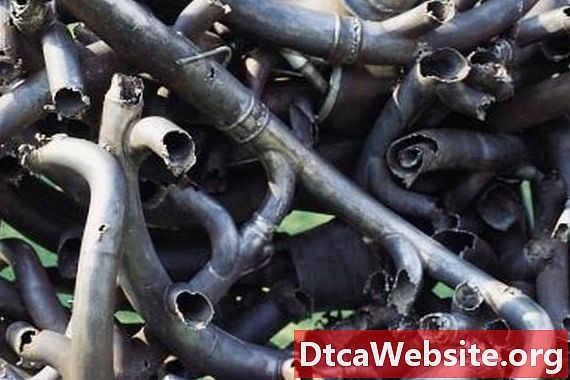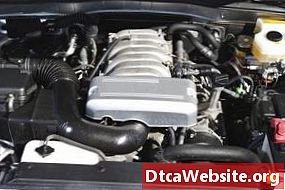
Contenu

From the very first automobiles, exhaust systems have been something of a showpiece. Today, manifolds, headers, pipes and tips come in many different materials and finishes. That variety makes a difference in terms of the approach, products and work required to clean them. However you go about making your pipes shine, make sure theyre dead-cold first; partly to avoid burning your fingertips off, but also to ensure that you dont burn off the cleaning products before theyve had a chance to do their jobs.
Step 1
Inspect the surface youre cleaning. The under-car sections of the exhaust system can be made from many materials, including mild or stainless steel, galvanized steel, aluminized steel or even titanium. The visible tips and headers can be of the same material as the rest of the exhaust, but just as often may be chrome plated, ceramic coated or cast iron, in the case of exhaust manifolds. Each of these materials requires a different approach.
Step 2
Remove the tips, header or headers for complete access, as needed. Tips are generally easy enough to remove; most of the time theyre held on with bolts, clamps or simple screws. Headers and exhaust manifolds can be fairly easy to remove on front-drive cars with inline, laterally placed engines. In other cases, like longitudinally placed V-6 or V-8 engines, they can be an utter nightmare. Its up to you to weigh the aggravation of removing the manifolds or headers with the ease of thoroughly cleaning them away from the car. If you decide to take them off, spray the bolts with some penetrating oil, let the oil sit for 10 minutes, and take the manifolds or headers off the car.
Step 3
Chrome and metallic ceramic coatings are surface coatings, so youll need to be gentle with them. The top coating of chrome is often only a few molecules thick, so abrasives are a bad idea. For cleaning these coatings, youre best off going down to your local motorcycle shop or Harley dealership and picking up a kit complete with cleaner and scrubby pads -- and polish, if you chose to go that route. The important thing is to buy a dedicated chrome exhaust cleaning agent -- not a chrome wheel cleaner. Exhaust cleaners are formulated for high heat and wont discolor the metal later. Follow the kit instructions, or spray the cleaner on the component liberally, let it sit for the recommended period of time, and scrub it off with a plastic-wire brush or very gently with a kitchen-type green scrubby pad. Rinse the part thoroughly with water when youre done.
Step 4
Cast iron, mild and stainless steel are much harder and more durable than coated surfaces, so you dont need to worry about being a little rougher with them. Start by cleaning them with a good engine degreaser and brush to remove the initial layer of grime, then rinse them off. Next, apply some metal polishing soap to an #0000 steel wool pad and start scrubbing. For cast-iron manifolds and mild steel, a brass wire wheel on a grinder will work better and faster and leave a nicer finish. Wear the proper protective gear and glasses -- those wheels do throw off some pretty nasty metal bristles. Use only a brass wire wheel. Steel wire is harder, will dig into the metal and can deposit tiny fragments that will rust later.
Step 5
Galvanized and aluminized steel are best cleaned with dish detergent and water, or aluminum wheel cleaner. These surfaces are rather ugly by nature, and theyll always have a thin, chalky layer on the outside. That layer protects the metal beneath, so you dont want to polish it off. Just clean it. Titanium reacts badly with most dedicated cleaners, so youre best off cleaning it with only dish detergent and water.
Polish the component to make it shine. Use a dedicated stainless polish and fine wire wool on stainless. Dont bother polishing cast iron or mild steel -- theyll both develop a coating of surface rust anyway, unless you apply a protectant exhaust coating over them. Same thing with galvanized and aluminized steel. Polish chrome and metallic powdercoat with a standard chrome polish and a microfiber towel. Avoid using any kind of abrasive on titanium except for mild aluminum polish. It wont likely hurt the metal, but it will change the look of that cool blue-gold heat discoloration titanium gets. Many people like polished, blued titanium; it does have a nice, dark, wet sheen to it that looks good on black or blue cars, but it doesnt have that bright, dramatic, blue-to-gold transition of heated titanium.
Warning
- Be careful when using any kind of abrasive on chrome and coated surfaces. That shine may look a mile deep, but the actual chrome coating is thinner than a human hair. Its harder than paint, but still easy to burn through with an aggressive abrasive.
Items you will need
- Penetrating oil
- Ratchet
- Socket set
- Wrench set
- Chrome exhaust cleaning and polishing kit, or dedicated cleaner, plastic scrub brush and green kitchen scrubby pads
- Engine degreaser
- Metal polishing soap
- #0000 steel wool
- Grinder and brass wire wheel -- optional
- Dish detergent
- Aluminum wheel cleaner
- Material-appropriate polish
- Microfiber towels


